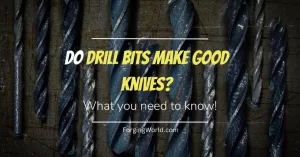It doesn’t matter if you are a knifemaker or a person looking to buy a knife, you have to understand the basics of knife dimensions. The length, width, and thickness are the three most important dimensions you should consider. In this article, we will primarily talk about the thickness of the blade.
So, how thick should a knife blade be?
The thickness of the knife blade primarily depends on the intended purpose. The ideal thickness for knives designed for slicing is typically 1/16 inch. On the other side, the recommended thickness for “cutting” knives is around 3/16 inches. Usually, the thicker the blade is, the stronger it is.
Note that this is just a general recommendation, the more specific measurement depends on the type of knife. This is what the rest of the article is all about. You will learn about the differences between slicing knives and cutting knives and the ideal thickness for each type of knife.
Let’s begin.
Difference Between Cutting and Slicing
As I have previously said, the ideal thickness mainly depends on the intended purpose of a knife. Some blades need to be sturdy while others must be thin enough for slicing. It all comes down to trade-offs between strength and slicing ability.
Generally, thicker blades are also stronger blades. On the other side, thin blades have slimmer profiles, allowing for much better and easier slicing. I mean, there is a reason we don’t carry around Exacto knives in our pockets. The blades of these knives are too thin which means higher chances of breaking. On the other hand, a pocket knife can be carried around due to its thickness.
When we say “cutting”, we usually mean separating into parts or to sever. Slicing, however, is generally referred to move through the material with a sharp blade. This is very important to distinguish when it comes to determining the ideal thickness of the blade.
For example, sometimes the main purpose of a knife is to make clear cuts. Combat and self-defense knives have to be sturdy in order to resist lateral forces and the buses of hard use. A kitchen knife needs to be able to make the slice extremely well and also be thin enough so that the blade can bend when needed.
Note that any knife that is properly sharpened with almost any blade profile or design can be nearly as sharp as some other knife. I mean, there are a couple of factors that might affect it but as long as their edge is the same thickness, they will cut the same. To put it even simpler, if you have a thick blade but it tapers down to a very thin edge, it can be as sharp as any other one.
Before you move on, I should also mention ways of measuring the thickness of the blade. In my experience, I have found that the best and also the most reliable way is to use a high-quality digital caliper.
Once you decide on a thickness, you can decide which grind will you use either to help reinforce the properties of that thickness or to make up for possible weakness. This is very important. For example, a very thick and sturdy blade (around 3/16″) will typically require a hollow or flat grind to reduce the weaknesses of its thickness. Keep in mind that even though the spine of the blade is thick, hollow or a flat grind won’t produce as much drag to the blade as it slices through a material.
If you want a thin blade, I would recommend reinforcing the blade with a saber grind. That way you will have a stronger blade than you would have otherwise. A flat grind would also work. However, such a knife should never be used for prying, chopping, or any heavy piercing.
However, there are cases when someone may need a knife that doesn’t have to go through the material. In such cases, the thickness of the blade is not so relevant as the edge grind and workmanship are. On the contrary, if the blade must pass through the material then you need to pay attention to the thickness as it will affect the amount of drag. This is when a hollow or flat grind may be superior to a saber grind.
In the end, it is all about strength vs slicing ability.
Ideal Thickness for Various Types of Knives
Hunting Knife
This knife is primarily used during hunting for preparing food. This typically includes skinning and boning. They are traditionally designed for cutting and mostly have a single-edge bevel. The ideal thickness of the blade is somewhere between 3/16″ and 1/4″. The usual edge thickness is 1/64″.
Butcher Knife
Butcher knives are used for breaking down cuts of meat and are usually found in restaurants and butcher shops. It has a slight curve which improves cutting through meat. Many types also have Granton edges which allow them to cuts through meat easily without shredding it. The ideal thickness of the blade is somewhere around 1/16″. The usual edge thickness is .008″- .012″.
Carving Knife
These are ideal knives for slicing cooked meats like roasted chicken, smoked ham, or fried turkey. They are usually thinner than chef knives, allowing them to slice thinner and more precise slices. The ideal thickness of the blade is somewhere between 1/16″. The usual edge thickness is 1/64″.
Cleaver
Cleaver is a long and wide blade. Its dimension makes it one of the largest knives in the kitchen. However, they still feature lightweight and thin blades that can be used for tasks like chopping vegetables, slicing meat, crushing garlic, and many more. The ideal thickness of the blade is somewhere between 1/16″ to 3/32″. The usual edge thickness is somewhere around .060″ to .090″.
Chefs Knife
A chef’s knife is one of the most versatile tools in the kitchen. They are used for a variety of cutting tasks. Chef knives typically have a wide blade that tapers to a point which makes them ideal for mincing, slicing, and chopping. They are available in many different sizes but the most popular are ones between 8″- 12″. The ideal thickness of the blade is 2/32″. The usual edge thickness is 1/64″.
Table of popular knives and their typical thickness
| Name | Blade Thickness | Edge Thickness |
| Hunting Knife | 3/16″ to 1/4″ | .008″- .012″ |
| Kitchen Knife | 5/64″ to 3/32″ | 1/64″ |
| Carving Knife | 1/16″ | 1/64″ |
| Cleaver | 1/16″ to 3/32″ | .060″ to .090″ |
| Chefs Knife | 2/32″ | 1/64″ |
| Boning Knife | 3/32″ | .005″ |
| Santoku Knife | 1/16″ | 0.100-0.110″ |
Edge Thickness
When it comes to edge thickness, we see a similar tradeoff in cutting ability versus strength. Typically, the thinner edge cuts much better but is also much weaker. Namely, thin edges are more prone to chipping or rolling over. On the other hand, the thick edge is very strong but won’t cut as well.
Keep in mind that the thickness of the Edge Bevel is primarily determined by the knifemaker. If the knife’s edges are thin, it can be extremely sharp even if it has a thick blade. The thickness of the edge is one of the things that can be changed by a knifemaker without a problem.
For instance, if you want to make your knife more effective at slicing, you can easily sharpen the edge and thin it out. Some knifemakers prefer a thicker edge of 40 degrees while others recommend 30 degrees. Few go thinner than that.
If you go below 30 degrees, your blade is more likely to chip or roll out. Slightly more sharpening at a wider angle will strengthen the blade due to the increased thickness. Just be careful not to grind too much of your blad because you won’t have much left. If you do the stock removal method, make sure you don’t use much wider and thicker than is necessary to make the blade.
For beginners, I would recommend having a blade thickness of no more than 1/8 inch as it won’t grind off much material. Another thing you have to understand is the difference between the primary bevel and the edge bevel. The primary bevel starts from the middle of the knife and goes towards the edge. The edge angle is at the very edge. This type of geometry leaves the edge thicker with more durability and strength.
However, some knives don’t even bother with the Edge Bevel at all. For example, Finnish Puuko has only one level that goes all the way down to the edge. Another good example of a single bevel is the convex grind which rounds into the edge.
Axes typically use this type of grind because it strengthens the edges. Unfortunately, axes can be difficult to sharpen, especially if you don’t have a lot of experience.



